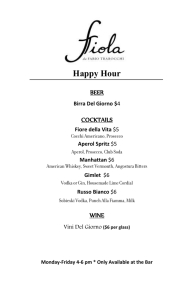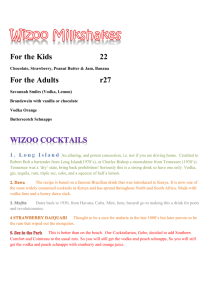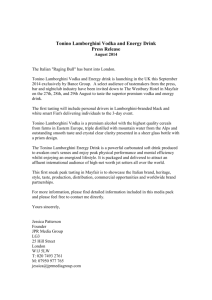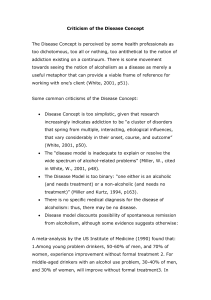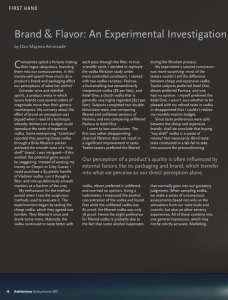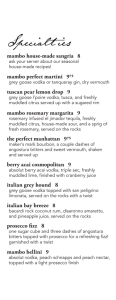The current super-saturation of the vodka market means brands
advertisement
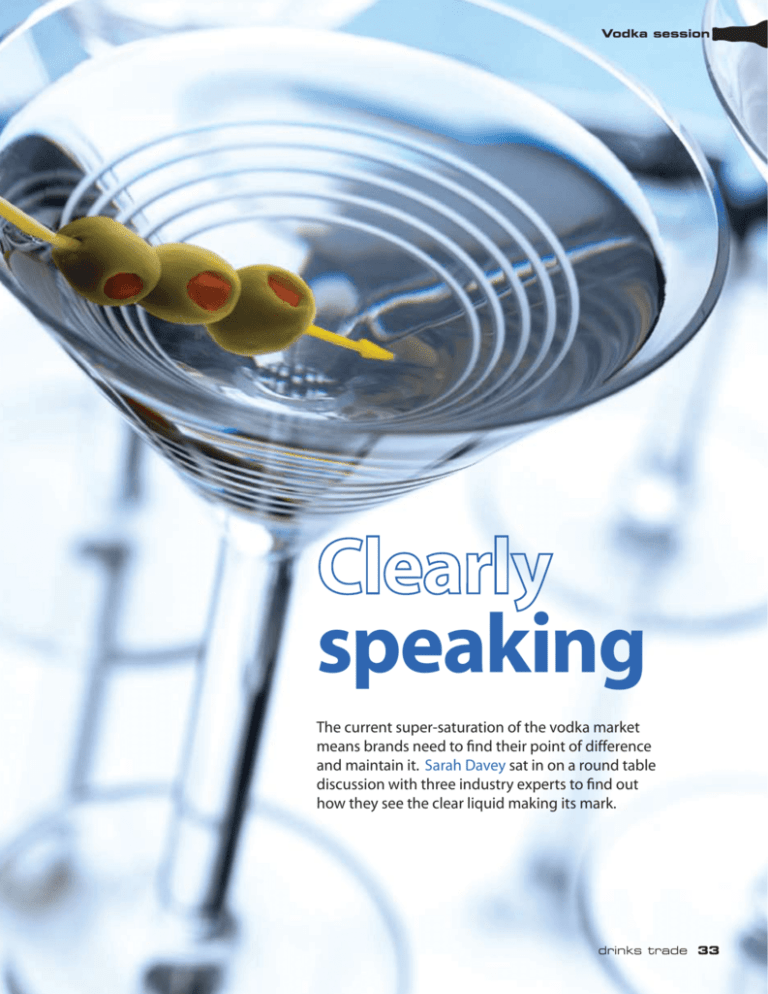
Vodka session speaking The current super-saturation of the vodka market means brands need to find their point of difference and maintain it. Sarah Davey sat in on a round table discussion with three industry experts to find out how they see the clear liquid making its mark. drinks trade 33 Vodka session Vitek Czernuszyn, Manuel Terron and Doug Van Tienen at the Drinks Trade vodka session. Following the excise on ready-to-drink products, there has been much talk of what will happen to the straight spirits industry. A recent Drinks Trade vodka session provided Polish distiller Vitek Czernuszyn of Vitek Vodka, industry representative Doug Van Tienen from Barmania! and training manager Manuel Terron from Southtrade International the opportunity to talk through a range of different vodkas as well as discuss trends they have noted during their time in the industry. The discussion focused on marketing, with all three men agreeing that the ‘neutrality’ of the spirit is a major factor in brand development. “I think one of the reasons vodka is so successful is because it is the ‘blank canvas’ of alcohol,” Vitek said. “It’s the blank canvas on which everyone can paint their masterpiece.” Traditionally, vodka was marketed as a tasteless alcohol. With most of the vodka-consuming markets being in Russia and Poland, there was not a need to identify one brand over another. In today’s market, however, the consumer is spoiled for choice and brands need that ‘special something’ to differentiate them from their competitors. Many brands are choosing to focus their marketing around the distillation process. “You’re never going to see a vodka company come out and say, ‘we’re tasteless and colourless’ – there’s just no saleability in that,” Manuel said. “What are they going to lean on, if not for the process? When you look at a clear definition of what vodka is, there is no notes, no character – there’s nothing but alcoholic heat.” Pick up any bottle of vodka and on the label you will be sure to find written somewhere how many times it has been distilled - but what does this really mean to those who are purchasing bottles? “When I present bartenders with a new vodka, the first question I am asked is, ‘How many times is it distilled?’” Doug said. “I say to them, ‘What does it actually mean when you ask me that question?’ and no one can answer it.” The team argued that while distillation will extract some of the strong alcoholic flavours that naturally come through, the process only really needs to be done once. “Once you’ve distilled the spirit you have eradicated any character,” Manuel said. “After the first distillation, there’s really nothing left to eliminate.” While some vodka brands are leaning on the distillation process to market the product, it has become increasingly popular to give layers of ‘flavour’ to the spirit. Manuel noted the tendency for brands to up-sell their flavour. “When vodka was first introduced to the market people were saying, ‘this doesn’t taste like anything’,” he said. “They were the people who enjoyed drinks such as juniper-heavy gins, austere cognacs and they identified with these spirits because they had certain taste profiles.” But the question asked was whether there was really any way of picking the ‘flavour’ in a non-flavoured vodka – and Vitek didn’t seem to think so. “At least when you speak about wine, there are different levels of bouquets and depth,” he 34 drinks trade said. “When I start hearing about the pepper and the berry in a vodka – and I like to think I have quite a good palate and nose – I just can’t find it.” Following a tasting session Doug conducted in Melbourne, 26 bartenders were presented with different vodkas and were asked to write accompanying tasting notes. When the results came back, not one bartender had the same tasting notes as the official version. “Asking someone to comment on a vodka’s taste is like asking someone how long a piece of string is,” said Manuel. “You’re going to get different answers from each person.” However, brands such as Ciroc have created a distinct flavour profile to set them apart from competitors. By introducing a lemon-peel aspect into the distillation process the brand is able to market itself as ‘vodka with a difference,’ rather than a flavoured vodka. “It’s that citrus, lemony thing that distinguishes it from all other vodkas,” Manuel said. “More than the taste, it’s very big on the nose. They have created this neutral vodka, I think based on the popularity of flavoured vodkas – they have added the aspect in without having to call themselves a citrus vodka.” Ciroc is considered by the majority of the market to fit in the ‘luxury’ category. But what is it that defines luxury? Once again, the team put it down to marketing. “The difference between a good vodka and a bad vodka is fairly self-evident,” Vitek said. “The difference between a good vodka and super-premium vodka? While there is a growing market that is starting to understand it, unless you are an avid vodka or martini drinker you will, I think, never be able to tell the difference.” Manuel agreed, stating that the line is constantly blurred especially between a super-premium and a luxury. “It takes a true aficionado to taste a vodka and say ‘This is good quality’ and then ‘This one is rubbish,’” he said. It is thanks to this blurred line that brands are jumping to marketing to get their point across. The ABSOLUT marketing campaign has been touted as possibly the most successful in the world. Everything, from the shape of the bottle right down to the use of the word ‘ABSOLUT-LY’ in various situations has given the brand exposure across the world. “It’s extraordinary to what degree they took the concept and applied it across everything in life,” Vitek said. The campaign has been so successful that people can identify the brand immediately – which makes for extremely powerful presence. Belvedere has also harnessed the power of marketing. First hitting the market around 100 years ago, Belvedere was known as the ‘pedestrian’ spirit and enjoyed by the lower classes in Poland. Originally owned by the Polish vodka promotion board (POLMOS), Vitek grew up knowing the ‘other’ Belvedere, and finds it amazing how pure marketing has turned the brand around. “I always have a laugh with my mother about this, because of how it was seen when I was younger,” said Vitek. “They have managed to turn this vodka into what is rapidly becoming the leading vodka in the world – purely through marketing!” Essentially, what the team agreed on was the fact that image is one of the most important things when it comes to marketing vodka. “What position does for real estate, image does for vodka,” Vitek stated. “It’s about image, image image – because that’s all they’ve got to sell.” Looking ahead for the category, Manuel predicts the gradual reduction of vodka-based cocktails on-premise. He believes this is because vodka does not carry the immediate flavours that a gin or a cognac exhibit, therefore bartenders are limited with what they can do with it. “I see the more knowledgeable the bartender becomes, the more they learn to despise vodka,” he said. “I say that because they can see that vodka doesn’t lend itself to their creativity.” He went on to say that the trend will most likely begin in the style bars and have a rippling effect, so that eventually on most cocktail menus there will only be four or five vodka-based cocktails. Following the RTD excise, sales for straight spirits spiked and it comes as no surprise that vodka still remains the most popular white spirit off-premise – with Doug observing that in the last two weeks his sales were up 30 percent on average. The Drinks Trade vodka session ended on a positive note, with the team agreeing that coupled with an image accepted by the consumer, there is no reason why vodka shouldn‘t have a long and happy shelf life.
